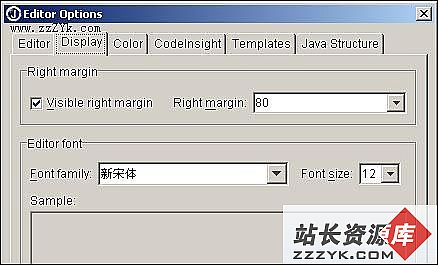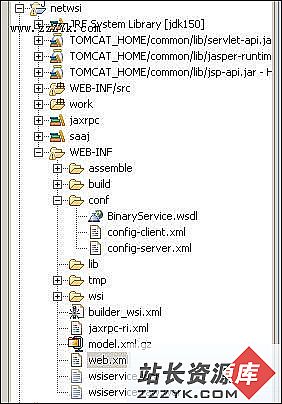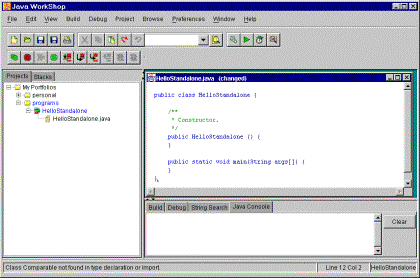当前位置:编程学习 > JSP >>
答案:下例是一个schem易做图断,电话号码数组嵌入到一个类型为"Person"的结构中,并且通过accessor "phone-numbers"访问它:
<易做图Type name="phoneNumber" base="string"/>
<element name="ArrayOfPhoneNumbers">
<complexType base="SOAP-ENC:Array">
<element name="phoneNumber" type="tns:phoneNumber" maxOccurs="unbounded"/>
</complexType>
<anyAttribute/>
</element>
<element name="Person">
<complexType>
<element name="name" type="string"/>
<element name="phoneNumbers" type="tns:ArrayOfPhoneNumbers"/>
</complexType>
</element>
<xyz:Person>
<name>John Hancock</name>
<phoneNumbers SOAP-ENC:arrayType="xyz:phoneNumber[2]">
<phoneNumber>206-555-1212</phoneNumber>
<phoneNumber>1-888-123-4567</phoneNumber>
</phoneNumbers>
</xyz:Person>
下面的例子中,数组值为single-reference,被编码为嵌入元素,包含它的元素名即为入口名:
<xyz:PurchaseOrder>
<CustomerName>Henry Ford</CustomerName>
<ShipTo>
<Street>5th Ave</Street>
<City>New York</City>
<State>NY</State>
<Zip>10010</Zip>
</ShipTo>
<PurchaseLineItems SOAP-ENC:arrayType="Order[2]">
<Order>
<Product>Apple</Product>
<Price>1.56</Price>
</Order>
<Order>
<Product>Peach</Product>
<Price>1.48</Price>
</Order>
</PurchaseLineItems>
</xyz:PurchaseOrder>
5.4.2.1 部分储值(partially transmitted)数组
SOAP提供了对部分储值(partially transmitted)数组的支持,如某些上下文中的可变数组。一个partially transmitted 数组由一个"SOAP-ENC:offset"属性(从第一个transmitted的元素开始的偏移量,基于0)指示。如果省略,偏移量取0。
下面的例子中数组的大小为5,但只有从0起,第三和第四个元素被储值。
<SOAP-ENC:Array ;SOAP-ENC:arrayType="xsd:string[5]" ;SOAP-ENC:offset="[2]">
<item>The third element</item>
<item>The fourth element</item>
</SOAP-ENC:Array>
5.4.2.2 稀疏数组Sparse Arrays
SOAP提供了对稀疏数组的支持。每个表示成员值的元素包含一个"SOAP-ENC:position"属性,用来指示它在数组中的位置。下例是两维字符串稀疏数组的例子,数组大小是4,但只用到第2个。
<SOAP-ENC:Array SOAP-ENC:arrayType="xsd:string[,][4]">
<SOAP-ENC:Array href=></SOAP-ENC:Array>
<SOAP-ENC:Array id="array-1" SOAP-ENC:arrayType="xsd:string[10,10]">
<item SOAP-ENC:position="[2,2]">Third row, third col</item>
<item SOAP-ENC:position="[7,2]">Eighth row, third col</item>
</SOAP-ENC:Array>
如果对array-1的引用仅发生在数组内部,上例也可以编码如下:
<SOAP-ENC:Array SOAP-ENC:arrayType="xsd:string[,][4]">
<SOAP-ENC:Array SOAP-ENC:position="[2]" SOAP-ENC:arrayType="xsd:string[10,10]>
<item SOAP-ENC:position="[2,2]">Third row, third col</item>
<item SOAP-ENC:position="[7,2]">Eighth row, third col</item>
</SOAP-ENC:Array>
</SOAP-ENC:Array>
5.4.3 一般复合类型
在这里提到的编码规则不仅仅限于accessor名已知的情况,如果accessor名是运行环境下实时获得的,编码规则同样适用,也就是说accessor编码成一个元素名与accessor名匹配的元素,同时accessor可能包含或者引用该元素的值。如果accessor包含类型不能事先确定的值,它必须包含一个合适的属性xsi:type 。
类似地,上述引用的规则已经足够用于复合类型的序列化,这些复合类型可能包含用名区分的accessors(结构)和用名及序数位置区分的accessors。(可能包含重复的accessor)实际上这并不要求任何schema模式包含这些类型,但更为准确的说法是:一个类型模型(type-model)schema如果有这些类型,就可以构造一个符合XML句法规则的schema和XML文档实例。
<xyz:PurchaseOrder>
<CustomerName>Henry Ford</CustomerName>
<ShipTo>
<Street>5th Ave</Street>
<City>New York</City>
<State>NY</State>
<Zip>10010</Zip>
</ShipTo>
<PurchaseLineItems>
<Order>
<Product>Apple</Product>
<Price>1.56</Price>
</Order>
<Order>
<Product>Peach</Product>
<Price>1.48</Price>
</Order>
</PurchaseLineItems>
</xyz:PurchaseOrder>
类似地,将一个结构上类似数组但实际上不是一个 SOAP-ENC:Array类型或者 SOAP-ENC:Array子类型的复合值序列化同样是允许的,例如:
<PurchaseLineItems>
<Order>
<Product>Apple</Product>
<Price>1.56</Price>
</Order>
<Order>
<Product>Peach</Product>
<Price>1.48</Price>
</Order>
</PurchaseLineItems>
5.5 缺省值
省略accessor元素意味着或者有一个缺省值或者值不知道。具体细节依靠这个accessor,方法和上下文。例如,对于多态accessor,省略accessor一般意味着一个Null值。同样,省略布尔accessor一般意味着False值或者值不知道,省略数字accessor一般意味着值为零或者值不知道。
5.6 SOAP root属性
SOAP root 属性可用于标记一个序列化root,从而一个对象可以反序列化(deserialized),而实际上该root并不是真正的对象root。这个属性有两个可选值"1" or "0"。对象真正的roots属性值为“1” ,序列化root但不是真正的root属性值也为“1”,元素如果要显式地指定不能为序列化root,只需将该属性设置为“0” SOAP root属性可以出现在SOAP头和SOAP体元素的任意子元素中。(译者注:SOAP root属性为0的元素不是一个独立的实
- 更多JSP疑问解答:
- jsp新手求指导,不要笑!
- 如何让一个form提取的值传递给多个jsp?
- DW中,新建的html页面能否有jsp或php代码?
- jsp 如何限制表单,实现只能填写特定的数据。
- jsp 和javabean结合的程序有问题
- 从数据库里取出的数据如何传递到另外的jsp页面中
- 你好,ext嵌入那个jsp页面,是不是还需要加上一些插件啊,不太懂,麻烦你了。
- JSP不能处理所有问题吗?还要来一大堆的TLD,TAG,XML。为JSP 非要 Servlet 不可吗?
- 光标离开时全角转半角在jsp中怎么实现
- jsp 页面 打开 pdf 文件 控制大小 和 工具栏 能发份源码么 谢啦
- jsp页面点保存按钮,运行缓慢,弹出对话框提示
- jsp刷新页面如何不闪屏
- jsp 与html 的交互问题?
- jsp小数显示问题 例如 我在oracle 数据库中查询出来的是 0.01 但是在jsp页面上就显示成 .01 没有前面的0
- jsp中日历控件





